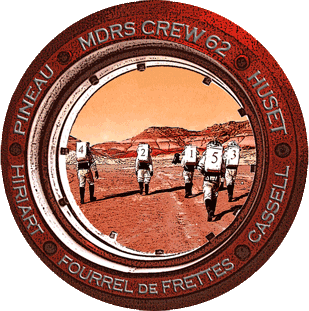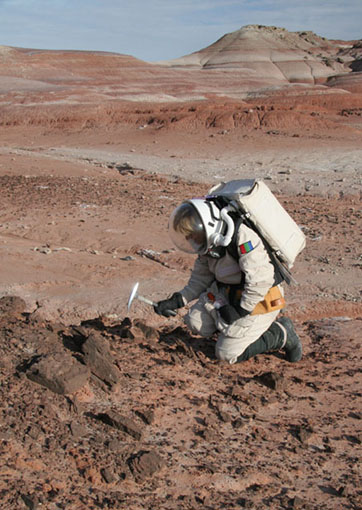
Mars Desert Research Station
|
|
Mission Overview
Since the Expedition 3 mission was such an out-of-this-world |
 |

|
|
 |
of challenges of working at MDRS (as if there were not already enough!). With the sentiment that the first Mars explorers would face similar challenges, we pulled together to form a fun and productive team. With teamwork and determination in the face of inclement weather, distressed equipment, and tools that were not always the perfect ones for the job, the crew was not only able to get the MDRS systems up an running, but also were able to conduct several science experiments related to the exploration of Mars. |

|
|
|
their own goals and activities, so the time spent there truly is what you make of it. Being the commander meant quite a bit of planning and organizing before we got to the Hab. Then while at the Hab it included re-planning due changing conditions, directing activities, training the crew, and other leadership tasks. Unfortunately there was some delay in selecting crews and we were notified of our mission only a month ahead of time. Luckily I have some great friends who have commanded many missions in the past that gave me a lot suggestions on how to run a safe, productive, and enjoyable mission. Then with an uncertainty not unlike a rocket launch, the five of us converged in the desert after braving a blizzardy drive. The sight of the Mars Desert Research Station nestled in the red dirt and rock hills instantly transported us to another world. We proceeded to power up the Hab and started the simulation. |

|

|
|
|
a temporary hold on EVAs to prevent red mud from coating everything. That did not keep us from rising early to get a jump on the day though. The winter weather gave us time to assess the state of the Hab and plan the activities for the coming weeks. We had a long to-do list that seemed to gain tasks quicker than they were checked off. We also used this time to study the local maps to plan EVA destinations. |

|
 Click to see the large panoramic |
|
|
our biology goals included the search for salt loving microorganisms called halophiles. This meant searching the hills and valleys for hyper-saline habitats, taking samples and mapping the locations for future studies. Unfortunately our "vertical rock sampling" EVA proposal was denied so we resorted to the next best thing. We conducted an EVA safety study on inclined surfaces with various steepness angles and surface compositions. Despite the cold nights, we took advantage of the dark night skies and used the Musk Observatory, which overlooks the Hab, to study many night time astronomical objects. We also tested an incident reporting method to document human factors issues throughout the mission. Last, and certainly not least, we spent most of our time on engineering projects. These ranged from maintaining basic survival systems to sewing crops in the greenhouse to be harvested by subsequent crews. |
|

Crewmembers from left to right
Top row:
Commander – Jon Pineau, space systems engineer (Golden, Colorado, USA)
Biologist – Catherine Fourrel de Frettes, biology student (Santa Fe, New Mexico, USA)
Field Engineer – Thomas Hiriart, aeronautics student (Toulouse, Midi-Pyrenees, France)
Chief Engineer – Chris Cassell orbital mechanics engineer (San Jose, California, USA)
Bottom row:
Executive Officer – Ben Huset, technical analyst and software architect (New Brighton, Minnesota, USA)
|
|
 |
Surface Excursions
With two operational ATVs used to simulate Mars rovers |
 |
|
|
The goal of this study was to determine whether or not a given slope is safe to be sampled with the limitations EVA equipment imposes on an explorer. We collected slope characteristics for twenty-three potential inclines for sampling including: the inclination, the ground type (rocky, sandy or clay), the hardness (hard or loose), the dryness (dry or muddy), the color, and finally, the most important factor, the overall slope safety (safe to climb upward/downward or safe to climb in a zigzag route). |

|
 |
|
|
More data points are desired, however the study provides some preliminary conclusions. - A dry clay soil is not safe to climb forward at an inclination more than 25° but it is safe most of the time to climb in zigzag at moderate inclination. - A dry sandy soil is almost always safe to climb forward and in zigzag if the inclination is less than 30° but is very tricky when the inclination increases. - We would recommend to always climb rocky soil in a zigzag route. Most of the time, it is safe if the inclination is less than 40° and if the rocks and soil is dry. - Wetness on any surface makes travel much more unstable, greatly reducing the safe-to-travel inclination. |
|
 |
 |
|
On this rotation, crew biologist Catherine Fourrel de Frettes sampled halophiles for post analysis back at her lab. Halophiles were focused on because they tolerate many harsh environmental stresses, including the ones expected to be found on Mars. In fact they are perfect candidate for life that might survive in concentrated brine solutions that might have once existed on Mars. Studying these fascinating organisms and understanding their mechanisms for survival are providing insights for the search of life elsewhere in the universe. The biology mission objectives were the sampling and retrieval of soil, rocks and minerals from previously identified hyper-saline habitats in order to find extreme halophilic microorganisms. The locations for the sample sites were based off those where halophiles were found by previous crews. |

|
 |
regarding the EVA suit and helmet limitations on mobility and clear vision. One concern for the sampling is the possibility of cross-contamination in the field while sampling, flaming the tools was out of the question and the usage of ethanol was not easy (mud was sticky and difficult to clean off the shovel). The sample bags were kept in the EVA suit and might also add a factor on cross-contamination. Sadly, no plating to isolate and possibly identify the presence of halophiles was conducted during this mission. However, the samples were taken back to Northern New Mexico College for complete biological analysis. |
Night Observations

The crew of MDRS 62 enjoyed several dark sky nights observing the heavens at the Musk Observatory. It was the first time looking through a telescope for some crew members who were awed by the mountains and craters of the Moon while other appreciated the dark, light pollution free nights. The sub-freezing temperatures meant crystal clear skies most nights. Although we were occasionally thwarted by cloudy skies and later on in the mission by the light of an almost full Moon, we were able to enjoy several evenings of observing the sights of the desert Southwest night skies. 
|
|
|
waxing crescent Moon and then continued on to Mars followed by various deep sky objects such as the Orion nebula, the Pleiades and the Andromeda galaxy. We observed comet Holmes (17P) but were unable to see all of it at one time in the eyepiece due to its large apparent size. It did, however, look great through binoculars. We were also treated to some of the Geminid meteor shower. Digital images were captured for some of these objects via a camera adaptor mounted on the telescope. We also spent one afternoon observing the Sun's solar flares and sun spots in H-alpha light through a telescope. Thanks goes to Ben for bringing the extra astronomical equipment! |

|
 |
Engineering
As the first MDRS crew of the 2007-08 field season, |
|
since the previous season. We cleaned the plant growing area and planters. We then placed soil and a variety of vegetable and herb seeds in the planters. Late in the mission germinating sprouts were seen emerging from the soil to eventually make a tasty supplement to the meals of other crews. |

|

|
|
|
MDRS Main Site Well that is all until next time. As always if you would like to see any other pictures of specific parts of the experience, or want higher resolution copies of what are on the web site, just let me know. Also, don't hesitate to ask if you have any questions. jon.pineau@colorado.edu Return to the MDRS Mission page here |
 |
